Cast Iron Pipe Work
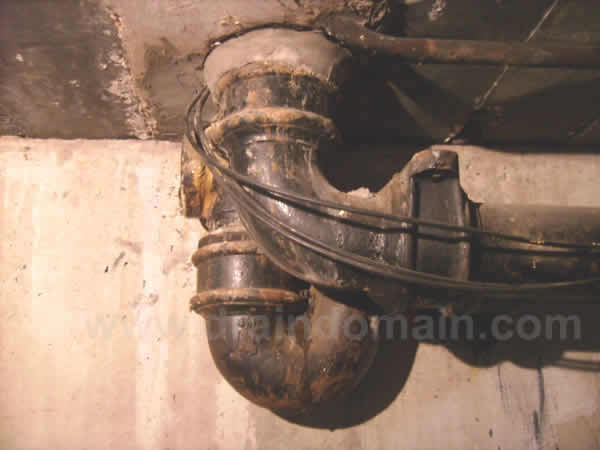 Often seen as a the above ground side of the drainage system with soil vent pipes, down spouts, manhole covers and gully grids being constructed from this robust material, however many miles of underground drainage systems were installed in cast iron pipe work. Often seen as a the above ground side of the drainage system with soil vent pipes, down spouts, manhole covers and gully grids being constructed from this robust material, however many miles of underground drainage systems were installed in cast iron pipe work.
It was often specified beneath city centre buildings, schools, colleges and hospitals, it was used for road crossings and inverted syphons with suspended pipe work in cellars, basements and service ducts often found to be constructed from cast iron pipe work. Cast iron was also the material of choice for many industrial processes where the waste product was considered too harsh for clay ware products, when sewer systems cross rivers and brooks cast iron was usually specified often suspended from bridges.
Cast Iron v Vitrified Clay Pipes
The main selling points in the early catalogues was that this was a more robust material than vitrified clay, it was stronger and less prone to damage during the back fill process or from vehicular movement. The pipes came in lengths of up to 9ft meaning fewer joints and the integrity of the joints that were used could be verified as they were sealed using lead wool, lead rope or a jute gaskin.
One of the initial concerns about the suitability of cast iron as an underground drainage material was that it would rust and deteriorate, an untreated pipe was expected to last 50 years while many of the trade catalogues boast that pipes treated with the wonderful sounding Dr Angus Smith`s solution would last twice as long. Glass enameled pipe work was also available however tests showed that even treated pipe work was unsuitable for certain industrial processes.
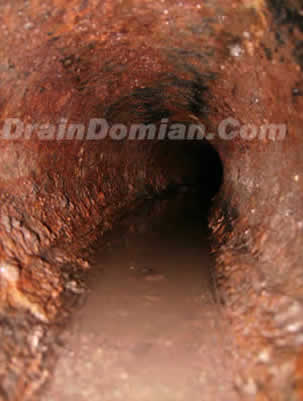 As a contractor i think i would have been more concerned about the weight of a 9ft length of cast iron pipe being passed down to me by a couple of blokes in clogs at the side of an eight foot deep un-shuttered trench, but life was cheap back then i suppose. The main reason that vitrified clay ware remained the more popular choice of pipe work was cost, with the cast iron systems often found to be 20% to 25% more expensive than clay. So if there was not an exact specification on the material to be used in went the clay pipe. As a contractor i think i would have been more concerned about the weight of a 9ft length of cast iron pipe being passed down to me by a couple of blokes in clogs at the side of an eight foot deep un-shuttered trench, but life was cheap back then i suppose. The main reason that vitrified clay ware remained the more popular choice of pipe work was cost, with the cast iron systems often found to be 20% to 25% more expensive than clay. So if there was not an exact specification on the material to be used in went the clay pipe.
We now know that many of these systems have deteriorated to some degree with the internal face of the pipe becoming furred and scaled and this obviously does nothing for the flow rate on foul drainage systems. Cast iron access plates seize and become difficult to remove whilst anti flood gullies and anti-flood valves fail as a water tight seal can not be accomplished due to the internal corrosion.
Cleaning Cast Iron Pipe work
Clearing these systems when they block is no more a problem than any other material if you can get sufficient access into a system, however descaling the systems proves to be a bigger challenge. High and ultra high pressure water jetting will remove some of the corrosion but as i have found from personal experience it is a thin line between removing the scaling and corrosion and blowing a dirty great hole in the side of the pipe. Descaling can be achieved with patient and extensive jetting using specialist jetting heads with flail chains attached
Typical Defects Found On Cast Iron Drainage Systems
Internal scaling and furring of the pipe wall reduces the internal bore and causes waste and solids to snag which in turn can lead to blockages, access plates and rodding eyes corrode and seal preventing access into the system, cast iron anti flood valves corrode preventing the water tight seal that they require in order to operate fully.
Repairing Defective Cast Iron Drainage Systems
Pipe lining is an option if the internal face can be descaled sufficiently, pipe bursting and failing that its time to get the shovels out.
Modern Ductile Iron Pipe Work
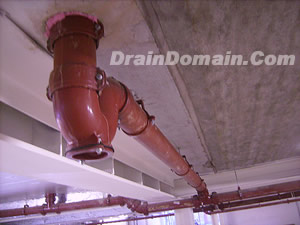 Modern systems are now coated internally using a cement mortar or polyurethane making them resistant to chemical and septic attack they are also abrasion resistant, the external wall of the pipe work is also coated usually with and an epoxy paint all of which ensure a longer pipeline life. Modern systems are now coated internally using a cement mortar or polyurethane making them resistant to chemical and septic attack they are also abrasion resistant, the external wall of the pipe work is also coated usually with and an epoxy paint all of which ensure a longer pipeline life.
Many systems are now push fit and much lighter than the earlier pipe work making the installation process quicker, they are less likely to be damaged during transporting and installation and they require less pipe bedding than other modern systems.
|

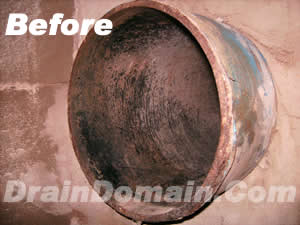
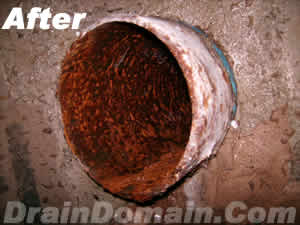
 Modern systems are now coated internally using a cement mortar or polyurethane making them resistant to chemical and septic attack they are also abrasion resistant, the external wall of the pipe work is also coated usually with and an epoxy paint all of which ensure a longer pipeline life.
Modern systems are now coated internally using a cement mortar or polyurethane making them resistant to chemical and septic attack they are also abrasion resistant, the external wall of the pipe work is also coated usually with and an epoxy paint all of which ensure a longer pipeline life. Often seen as a the above ground side of the drainage system with soil vent pipes, down spouts, manhole covers and gully grids being constructed from this robust material, however many miles of underground drainage systems were installed in cast iron pipe work.
Often seen as a the above ground side of the drainage system with soil vent pipes, down spouts, manhole covers and gully grids being constructed from this robust material, however many miles of underground drainage systems were installed in cast iron pipe work. As a contractor i think i would have been more concerned about the weight of a 9ft length of cast iron pipe being passed down to me by a couple of blokes in clogs at the side of an eight foot deep un-shuttered trench, but life was cheap back then i suppose. The main reason that vitrified clay ware remained the more popular choice of pipe work was cost, with the cast iron systems often found to be 20% to 25% more expensive than clay. So if there was not an exact specification on the material to be used in went the clay pipe.
As a contractor i think i would have been more concerned about the weight of a 9ft length of cast iron pipe being passed down to me by a couple of blokes in clogs at the side of an eight foot deep un-shuttered trench, but life was cheap back then i suppose. The main reason that vitrified clay ware remained the more popular choice of pipe work was cost, with the cast iron systems often found to be 20% to 25% more expensive than clay. So if there was not an exact specification on the material to be used in went the clay pipe. 
